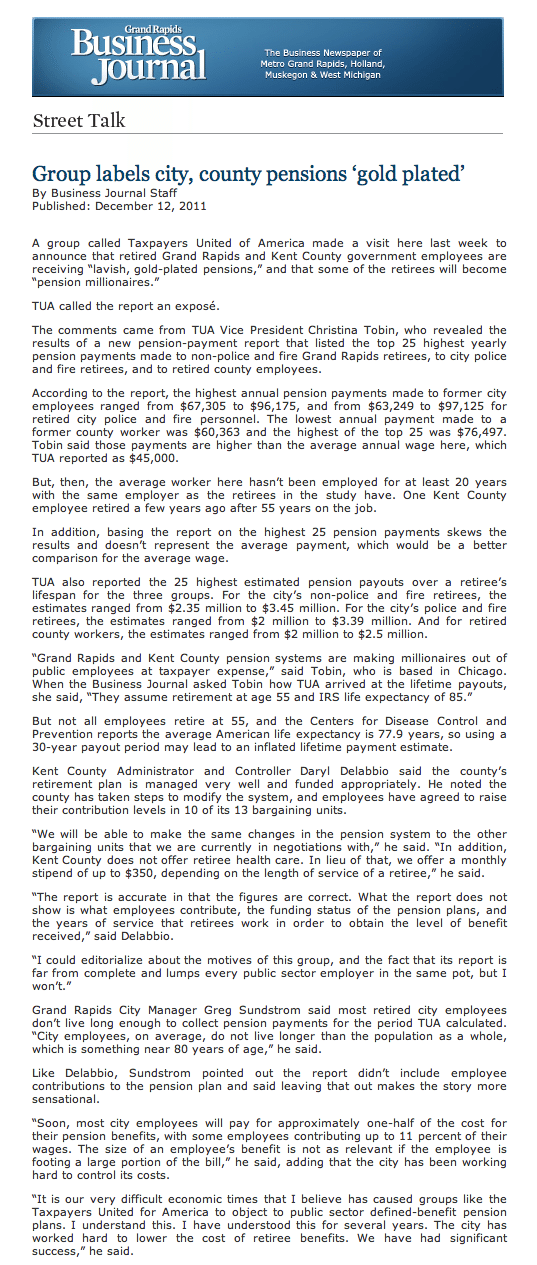Findings from TUA’s pension project on Grand Rapids, Michigan are featured in the following Grand Rapid Business Journal article.
 By Business Journal Staff
By Business Journal Staff
Published: December 12, 2011
A group called Taxpayers United of America made a visit here last week to announce that retired Grand Rapids and Kent County government employees are receiving “lavish, gold-plated pensions,” and that some of the retirees will become “pension millionaires.”
TUA called the report an exposé.
The comments came from TUA Vice President Christina Tobin, who revealed the results of a new pension-payment report that listed the top 25 highest yearly pension payments made to non-police and fire Grand Rapids retirees, to city police and fire retirees, and to retired county employees.
According to the report, the highest annual pension payments made to former city employees ranged from $67,305 to $96,175, and from $63,249 to $97,125 for retired city police and fire personnel. The lowest annual payment made to a former county worker was $60,363 and the highest of the top 25 was $76,497. Tobin said those payments are higher than the average annual wage here, which TUA reported as $45,000.
But, then, the average worker here hasn’t been employed for at least 20 years with the same employer as the retirees in the study have. One Kent County employee retired a few years ago after 55 years on the job.
In addition, basing the report on the highest 25 pension payments skews the results and doesn’t represent the average payment, which would be a better comparison for the average wage.
TUA also reported the 25 highest estimated pension payouts over a retiree’s lifespan for the three groups. For the city’s non-police and fire retirees, the estimates ranged from $2.35 million to $3.45 million. For the city’s police and fire retirees, the estimates ranged from $2 million to $3.39 million. And for retired county workers, the estimates ranged from $2 million to $2.5 million.
“Grand Rapids and Kent County pension systems are making millionaires out of public employees at taxpayer expense,” said Tobin, who is based in Chicago. When the Business Journal asked Tobin how TUA arrived at the lifetime payouts, she said, “They assume retirement at age 55 and IRS life expectancy of 85.”
But not all employees retire at 55, and the Centers for Disease Control and Prevention reports the average American life expectancy is 77.9 years, so using a 30-year payout period may lead to an inflated lifetime payment estimate.
Kent County Administrator and Controller Daryl Delabbio said the county’s retirement plan is managed very well and funded appropriately. He noted the county has taken steps to modify the system, and employees have agreed to raise their contribution levels in 10 of its 13 bargaining units.
“We will be able to make the same changes in the pension system to the other bargaining units that we are currently in negotiations with,” he said. “In addition, Kent County does not offer retiree health care. In lieu of that, we offer a monthly stipend of up to $350, depending on the length of service of a retiree,” he said.
“The report is accurate in that the figures are correct. What the report does not show is what employees contribute, the funding status of the pension plans, and the years of service that retirees work in order to obtain the level of benefit received,” said Delabbio.
“I could editorialize about the motives of this group, and the fact that its report is far from complete and lumps every public sector employer in the same pot, but I won’t.”
Grand Rapids City Manager Greg Sundstrom said most retired city employees don’t live long enough to collect pension payments for the period TUA calculated. “City employees, on average, do not live longer than the population as a whole, which is something near 80 years of age,” he said.
Like Delabbio, Sundstrom pointed out the report didn’t include employee contributions to the pension plan and said leaving that out makes the story more sensational.
“Soon, most city employees will pay for approximately one-half of the cost for their pension benefits, with some employees contributing up to 11 percent of their wages. The size of an employee’s benefit is not as relevant if the employee is footing a large portion of the bill,” he said, adding that the city has been working hard to control its costs.
“It is our very difficult economic times that I believe has caused groups like the Taxpayers United for America to object to public sector defined-benefit pension plans. I understand this. I have understood this for several years. The city has worked hard to lower the cost of retiree benefits. We have had significant success,” he said.
The complete TUA report is at taxpayersunitedofamerica.org. It also includes pension payments for retired public school teachers and the names of the top 25 retirees in each group.




